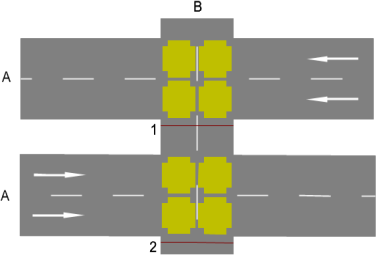Modeling signal controls for pedestrians
1. Ensure that the following network objects are defined:
- Links for pedestrians in which the attribute Is pedestrian area is selected (Defining pedestrian links). (B) in the figure.
- Signal control with signal groups on the links (Defining signal groups in the signal controller editor). (1), (2) in the figure.
2. Select the desired pedestrian classes in the attribute PedClasses of the signal heads which lie in the pedestrian link (Attributes of signal heads). A pedestrian observes a signal head only if it belongs to a pedestrian type whose pedestrian class is selected in the attribute of the signal head.
The figure shows a modeling example:

The signal head works exclusively in the direction of the pedestrian link at the time when the signal head is inserted on the pedestrian link. The signal head does not work for the opposite direction. The direction of the pedestrian link is indicated by yellow arrows on the edge of the pedestrian link. These are arrows are displayed when you mark the pedestrian link.
- When the signal head is inserted in the direction of the pedestrian link, it is either open or closed for pedestrians walking in this direction. This depends on the dynamic state of the assigned signal group:
- Red and amber: The signal head is closed. Pedestrians stop at the signal head until it no longer shows red or amber.
- Other cases: The signal head is open, pedestrians can continue walking on the pedestrian link.
- Pedestrians can always pass the signal head when walking In the opposite direction of the pedestrian link, regardless of its condition. To supply these pedestrians with data via signal heads, reverse the direction of the pedestrian link and insert another signal head. You can then switch back to the original direction of the pedestrian link. This means there are two signal heads on the pedestrian link that have an impact on different directions.
3. To reverse the direction of the link, click the link and hold down the Tab key.
The dynamic state (for example red or green) of the signal head is linked to the dynamic state of the respective signal group to which the signal head belongs.
Superordinate topic:

